Arijit Sur
Harnessing Multi-resolution and Multi-scale Attention for Underwater Image Restoration
Aug 19, 2024Abstract:Underwater imagery is often compromised by factors such as color distortion and low contrast, posing challenges for high-level vision tasks. Recent underwater image restoration (UIR) methods either analyze the input image at full resolution, resulting in spatial richness but contextual weakness, or progressively from high to low resolution, yielding reliable semantic information but reduced spatial accuracy. Here, we propose a lightweight multi-stage network called Lit-Net that focuses on multi-resolution and multi-scale image analysis for restoring underwater images while retaining original resolution during the first stage, refining features in the second, and focusing on reconstruction in the final stage. Our novel encoder block utilizes parallel $1\times1$ convolution layers to capture local information and speed up operations. Further, we incorporate a modified weighted color channel-specific $l_1$ loss ($cl_1$) function to recover color and detail information. Extensive experimentations on publicly available datasets suggest our model's superiority over recent state-of-the-art methods, with significant improvement in qualitative and quantitative measures, such as $29.477$ dB PSNR ($1.92\%$ improvement) and $0.851$ SSIM ($2.87\%$ improvement) on the EUVP dataset. The contributions of Lit-Net offer a more robust approach to underwater image enhancement and super-resolution, which is of considerable importance for underwater autonomous vehicles and surveillance. The code is available at: https://github.com/Alik033/Lit-Net.
ML-CrAIST: Multi-scale Low-high Frequency Information-based Cross black Attention with Image Super-resolving Transformer
Aug 19, 2024



Abstract:Recently, transformers have captured significant interest in the area of single-image super-resolution tasks, demonstrating substantial gains in performance. Current models heavily depend on the network's extensive ability to extract high-level semantic details from images while overlooking the effective utilization of multi-scale image details and intermediate information within the network. Furthermore, it has been observed that high-frequency areas in images present significant complexity for super-resolution compared to low-frequency areas. This work proposes a transformer-based super-resolution architecture called ML-CrAIST that addresses this gap by utilizing low-high frequency information in multiple scales. Unlike most of the previous work (either spatial or channel), we operate spatial and channel self-attention, which concurrently model pixel interaction from both spatial and channel dimensions, exploiting the inherent correlations across spatial and channel axis. Further, we devise a cross-attention block for super-resolution, which explores the correlations between low and high-frequency information. Quantitative and qualitative assessments indicate that our proposed ML-CrAIST surpasses state-of-the-art super-resolution methods (e.g., 0.15 dB gain @Manga109 $\times$4). Code is available on: https://github.com/Alik033/ML-CrAIST.
Zero-Shot Underwater Gesture Recognition
Jul 19, 2024



Abstract:Hand gesture recognition allows humans to interact with machines non-verbally, which has a huge application in underwater exploration using autonomous underwater vehicles. Recently, a new gesture-based language called CADDIAN has been devised for divers, and supervised learning methods have been applied to recognize the gestures with high accuracy. However, such methods fail when they encounter unseen gestures in real time. In this work, we advocate the need for zero-shot underwater gesture recognition (ZSUGR), where the objective is to train a model with visual samples of gestures from a few ``seen'' classes only and transfer the gained knowledge at test time to recognize semantically-similar unseen gesture classes as well. After discussing the problem and dataset-specific challenges, we propose new seen-unseen splits for gesture classes in CADDY dataset. Then, we present a two-stage framework, where a novel transformer learns strong visual gesture cues and feeds them to a conditional generative adversarial network that learns to mimic feature distribution. We use the trained generator as a feature synthesizer for unseen classes, enabling zero-shot learning. Extensive experiments demonstrate that our method outperforms the existing zero-shot techniques. We conclude by providing useful insights into our framework and suggesting directions for future research.
Segmentation of tibiofemoral joint tissues from knee MRI using MtRA-Unet and incorporating shape information: Data from the Osteoarthritis Initiative
Jan 23, 2024Abstract:Knee Osteoarthritis (KOA) is the third most prevalent Musculoskeletal Disorder (MSD) after neck and back pain. To monitor such a severe MSD, a segmentation map of the femur, tibia and tibiofemoral cartilage is usually accessed using the automated segmentation algorithm from the Magnetic Resonance Imaging (MRI) of the knee. But, in recent works, such segmentation is conceivable only from the multistage framework thus creating data handling issues and needing continuous manual inference rendering it unable to make a quick and precise clinical diagnosis. In order to solve these issues, in this paper the Multi-Resolution Attentive-Unet (MtRA-Unet) is proposed to segment the femur, tibia and tibiofemoral cartilage automatically. The proposed work has included a novel Multi-Resolution Feature Fusion (MRFF) and Shape Reconstruction (SR) loss that focuses on multi-contextual information and structural anatomical details of the femur, tibia and tibiofemoral cartilage. Unlike previous approaches, the proposed work is a single-stage and end-to-end framework producing a Dice Similarity Coefficient (DSC) of 98.5% for the femur, 98.4% for the tibia, 89.1% for Femoral Cartilage (FC) and 86.1% for Tibial Cartilage (TC) for critical MRI slices that can be helpful to clinicians for KOA grading. The time to segment MRI volume (160 slices) per subject is 22 sec. which is one of the fastest among state-of-the-art. Moreover, comprehensive experimentation on the segmentation of FC and TC which is of utmost importance for morphology-based studies to check KOA progression reveals that the proposed method has produced an excellent result with binary segmentation
DatUS^2: Data-driven Unsupervised Semantic Segmentation with Pre-trained Self-supervised Vision Transformer
Jan 23, 2024Abstract:Successive proposals of several self-supervised training schemes continue to emerge, taking one step closer to developing a universal foundation model. In this process, the unsupervised downstream tasks are recognized as one of the evaluation methods to validate the quality of visual features learned with a self-supervised training scheme. However, unsupervised dense semantic segmentation has not been explored as a downstream task, which can utilize and evaluate the quality of semantic information introduced in patch-level feature representations during self-supervised training of a vision transformer. Therefore, this paper proposes a novel data-driven approach for unsupervised semantic segmentation (DatUS^2) as a downstream task. DatUS^2 generates semantically consistent and dense pseudo annotate segmentation masks for the unlabeled image dataset without using any visual-prior or synchronized data. We compare these pseudo-annotated segmentation masks with ground truth masks for evaluating recent self-supervised training schemes to learn shared semantic properties at the patch level and discriminative semantic properties at the segment level. Finally, we evaluate existing state-of-the-art self-supervised training schemes with our proposed downstream task, i.e., DatUS^2. Also, the best version of DatUS^2 outperforms the existing state-of-the-art method for the unsupervised dense semantic segmentation task with 15.02% MiOU and 21.47% Pixel accuracy on the SUIM dataset. It also achieves a competitive level of accuracy for a large-scale and complex dataset, i.e., the COCO dataset.
DiRaC-I: Identifying Diverse and Rare Training Classes for Zero-Shot Learning
Dec 31, 2022Abstract:Inspired by strategies like Active Learning, it is intuitive that intelligently selecting the training classes from a dataset for Zero-Shot Learning (ZSL) can improve the performance of existing ZSL methods. In this work, we propose a framework called Diverse and Rare Class Identifier (DiRaC-I) which, given an attribute-based dataset, can intelligently yield the most suitable "seen classes" for training ZSL models. DiRaC-I has two main goals - constructing a diversified set of seed classes, followed by a visual-semantic mining algorithm initialized by these seed classes that acquires the classes capturing both diversity and rarity in the object domain adequately. These classes can then be used as "seen classes" to train ZSL models for image classification. We adopt a real-world scenario where novel object classes are available to neither DiRaC-I nor the ZSL models during training and conducted extensive experiments on two benchmark data sets for zero-shot image classification - CUB and SUN. Our results demonstrate DiRaC-I helps ZSL models to achieve significant classification accuracy improvements.
Resolving Semantic Confusions for Improved Zero-Shot Detection
Dec 12, 2022Abstract:Zero-shot detection (ZSD) is a challenging task where we aim to recognize and localize objects simultaneously, even when our model has not been trained with visual samples of a few target ("unseen") classes. Recently, methods employing generative models like GANs have shown some of the best results, where unseen-class samples are generated based on their semantics by a GAN trained on seen-class data, enabling vanilla object detectors to recognize unseen objects. However, the problem of semantic confusion still remains, where the model is sometimes unable to distinguish between semantically-similar classes. In this work, we propose to train a generative model incorporating a triplet loss that acknowledges the degree of dissimilarity between classes and reflects them in the generated samples. Moreover, a cyclic-consistency loss is also enforced to ensure that generated visual samples of a class highly correspond to their own semantics. Extensive experiments on two benchmark ZSD datasets - MSCOCO and PASCAL-VOC - demonstrate significant gains over the current ZSD methods, reducing semantic confusion and improving detection for the unseen classes.
Knee Osteoarthritis Severity Prediction using an Attentive Multi-Scale Deep Convolutional Neural Network
Jun 27, 2021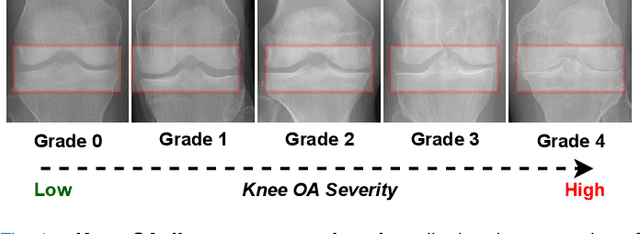

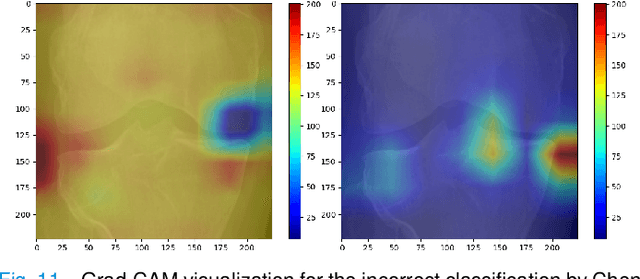
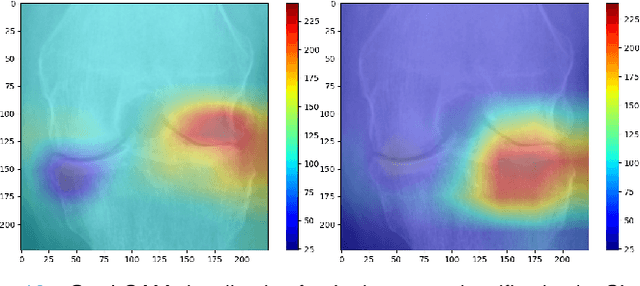
Abstract:Knee Osteoarthritis (OA) is a destructive joint disease identified by joint stiffness, pain, and functional disability concerning millions of lives across the globe. It is generally assessed by evaluating physical symptoms, medical history, and other joint screening tests like radiographs, Magnetic Resonance Imaging (MRI), and Computed Tomography (CT) scans. Unfortunately, the conventional methods are very subjective, which forms a barrier in detecting the disease progression at an early stage. This paper presents a deep learning-based framework, namely OsteoHRNet, that automatically assesses the Knee OA severity in terms of Kellgren and Lawrence (KL) grade classification from X-rays. As a primary novelty, the proposed approach is built upon one of the most recent deep models, called the High-Resolution Network (HRNet), to capture the multi-scale features of knee X-rays. In addition, we have also incorporated an attention mechanism to filter out the counterproductive features and boost the performance further. Our proposed model has achieved the best multiclass accuracy of 71.74% and MAE of 0.311 on the baseline cohort of the OAI dataset, which is a remarkable gain over the existing best-published works. We have also employed the Gradient-based Class Activation Maps (Grad-CAMs) visualization to justify the proposed network learning.
Multi-Contextual Design of Convolutional Neural Network for Steganalysis
Jun 19, 2021



Abstract:In recent times, deep learning-based steganalysis classifiers became popular due to their state-of-the-art performance. Most deep steganalysis classifiers usually extract noise residuals using high-pass filters as preprocessing steps and feed them to their deep model for classification. It is observed that recent steganographic embedding does not always restrict their embedding in the high-frequency zone; instead, they distribute it as per embedding policy. Therefore, besides noise residual, learning the embedding zone is another challenging task. In this work, unlike the conventional approaches, the proposed model first extracts the noise residual using learned denoising kernels to boost the signal-to-noise ratio. After preprocessing, the sparse noise residuals are fed to a novel Multi-Contextual Convolutional Neural Network (M-CNET) that uses heterogeneous context size to learn the sparse and low-amplitude representation of noise residuals. The model performance is further improved by incorporating the Self-Attention module to focus on the areas prone to steganalytic embedding. A set of comprehensive experiments is performed to show the proposed scheme's efficacy over the prior arts. Besides, an ablation study is given to justify the contribution of various modules of the proposed architecture.
Wavelength-based Attributed Deep Neural Network for Underwater Image Restoration
Jun 15, 2021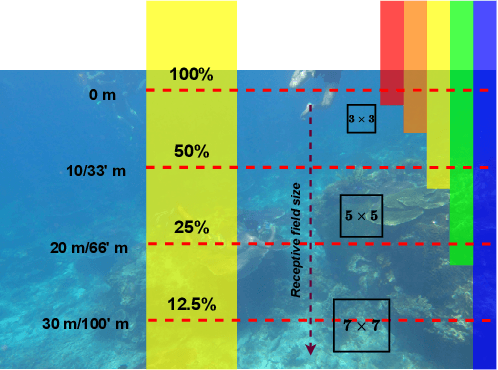
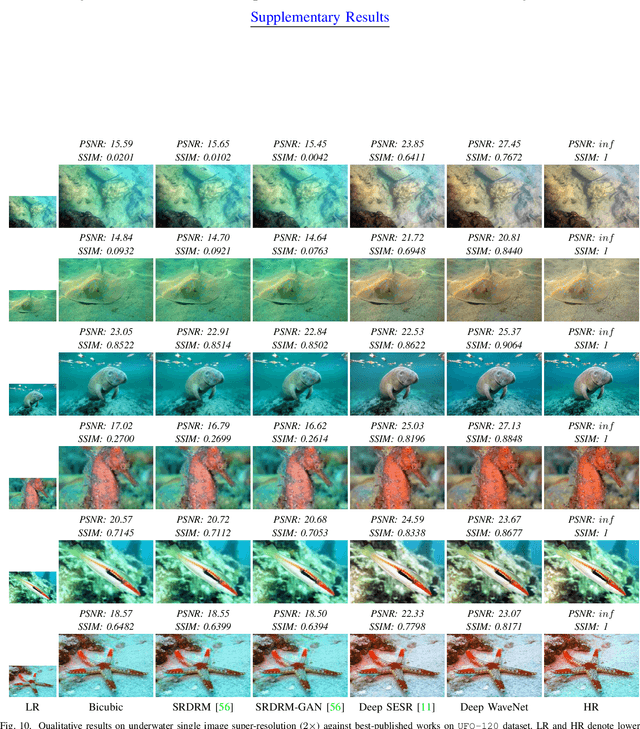


Abstract:Underwater images, in general, suffer from low contrast and high color distortions due to the non-uniform attenuation of the light as it propagates through the water. In addition, the degree of attenuation varies with the wavelength resulting in the asymmetric traversing of colors. Despite the prolific works for underwater image restoration (UIR) using deep learning, the above asymmetricity has not been addressed in the respective network engineering. As the first novelty, this paper shows that attributing the right receptive field size (context) based on the traversing range of the color channel may lead to a substantial performance gain for the task of UIR. Further, it is important to suppress the irrelevant multi-contextual features and increase the representational power of the model. Therefore, as a second novelty, we have incorporated an attentive skip mechanism to adaptively refine the learned multi-contextual features. The proposed framework, called Deep WaveNet, is optimized using the traditional pixel-wise and feature-based cost functions. An extensive set of experiments have been carried out to show the efficacy of the proposed scheme over existing best-published literature on benchmark datasets. More importantly, we have demonstrated a comprehensive validation of enhanced images across various high-level vision tasks, e.g., underwater image semantic segmentation, and diver's 2D pose estimation. A sample video to exhibit our real-world performance is available at \url{https://www.youtube.com/watch?v=8qtuegBdfac}.
 Add to Chrome
Add to Chrome Add to Firefox
Add to Firefox Add to Edge
Add to Edge